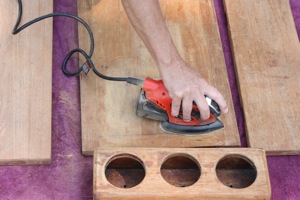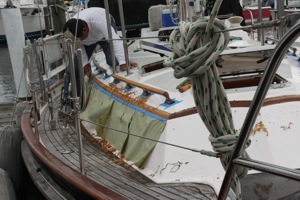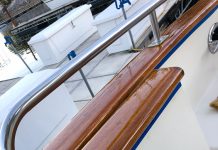Day 4 and it’s finally time to sand. At this point of the process, I begin to think we’ll never ever be done with the PREP work, let alone actually get to the fun part of this process! I love making it pretty, I’m not so enthused about the prep … but, it’s a necessary evil… I’ve discovered the hard way that if you don’t do the prep part correctly, cut corners, the varnish or cetol doesn’t last. So we sand.

But before we sand, if the blue tape has been destroyed by the brightening or stripping processes, we remove the blue tape and retape.
Then we sand the already stripped and brightened teak with 220 grit sandpaper – I find it easier to use the little Black & Decker mouse sander for the flat surfaces, the grab rails we had to sand by hand – good thing our teak expert, Rodney was still helping at this point! It really didn’t take long to go over all the area with the 220 grit but there are a few tricks of the trade … first, never never never sand against or across the grain – you always want to sand in one direction with the grain. The rationale is that sanding in one direction with the grain makes the grain “lay down” versus pulling it back up again when you go the other way? Logic doesn’t entirely make sense to me, but most of the time it was easy enough to sand one way, so we did. It got really tricky with the curve of the teak grab rails being rounded and I’m quite sure we didn’t do it perfectly, but good enough.

Secondly, you don’t want to sand too much – especially if you’re using an electric sander. Teak has soft grooves and hard ridges and a common mistake is to sand it down too much – thus shortening the lifespan of the particular piece of teak. It’s easy to press down just a bit harder when using an electric sander and inadvertently remove more of your valuable teak than ideal. Luckily for us, all our teak is hefty and hearty and not thin anywhere, but still we want to be careful not to “waste” it.
And actually on this particular project, the sanding is just a final go over – so we skip sanding with the little Black & Decker mouse sander with 220 grit and go directly to hand sanding with the 220 grit.
After that, we wipe it down with a damp cloth to get the residual dust off – some use acetone, but we’ve found if we’re just getting ready for a finer level of sanding, a damp cloth is good enough.
Then it was time to fine sand with the 320 grit sandpaper for the final prep. Unfortunately on this part of the project, I was so ready to get to the “fun” stuff, that I didn’t take many photos, so photos of the sanding process are non-existant. But it’s the same process – a light “go-over” with the 320 grit sandpaper. We like to wrap the sandpaper around a small wooden block just so it’s easier to hold onto for the flat surfaces.
By the end of the day’s sanding, neither of us had fingerprints left … a casualty of the process. Rodney, The Varnish Artist, informs us that it takes a few days to regenerate fingerprints. 🙂 Since he sands everything pretty much by hand, for large jobs he actually blue tapes the ends of his fingers! Too bad he didn’t relay that trick before we sanded our fingerprints off!

We wiped it all down to get rid of all the dust particles, then retaped any places that needed it so that the entire project was outlined in blue tape. For the eyebrow rails, we actually taped paper over the cabin sides again since I’m a total amateur — that way if I accidentally have a run — especially with the thinned sealer coats, it’s on the paper rather than on the gelcoat!
How exciting! FINALLY the prep is done and done correctly, no cutting corners so as long as I do the varnish correctly too, it should last a long, long time! 🙂














[…] It’s Teak Week! Day 4: Sanding & Wetsanding […]